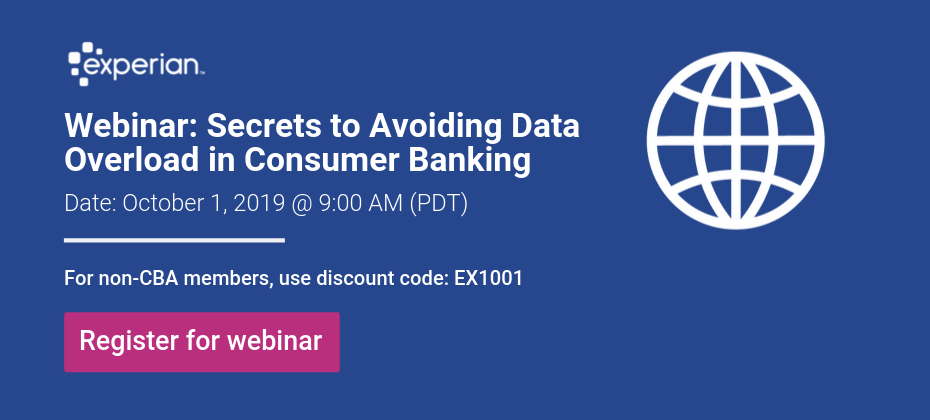All posts by Kelly Nguyen

AI, machine learning, and Big Data – these are no longer just buzzwords. The advanced analytics techniques and analytics-based tools that are available to financial institutions today are powerful but underutilized. And the 30% of banks, credit unions and fintechs successfully deploying them are driving better data-driven decisions, more positive customer experiences and stronger profitability. As the opportunities surrounding advanced analytics continue to grow, more lenders are eager to adopt these capabilities to make the most of their datasets. And it’s understandable that financial institution are excited at the possibilities and insights that advanced analytics can bring to their business. However, there are some key considerations to keep in mind as you begin this important digital transformation. Here are three things you should do as your financial institution begins its advanced analytics journey. Ensure consistent and clean data quality Companies have a plethora of data and information on their customers. The main hurdles that many organizations face is being able to turn this information into a clean and cohesive dataset and formulating an effective and long-term data management strategy. Trying to implement advanced analytic capabilities while lacking an effective data governance strategy is like building a house on a poor foundation – likely to fail. Data quality issues, such as inconsistent data, data gaps, and incomplete and duplicated data, also haunt many organizations, making it difficult to complete their analytics objectives. Ensuring that issues in data quality are managed is the key to gaining the correct insights for your business. Establish and maintain a single view of customers The power of advanced analytics can only be as strong as the data provided. Unfortunately, many companies don’t realize that advanced analytics is much more powerful when companies are able to establish a single view of their customers. Companies need to establish and maintain a single view of customers in order to begin implementing advanced analytic capabilities. According to Experian research, a single customer view is a consistent, accurate and holistic view of your organization’s customers, prospects, and their data. Having full visibility and a 360 view into your customers paves the way for companies to make personalized, relevant, timely and precise decisions. But as many companies have begun to realize, getting this single view of customers is easier said than done. Organizations need to make sure that data should always be up-to-date, unique and available in order to begin a complete digital transformation. Ensure the right resources and commitment for your advanced analytics initiative It’s important to have the top-down commitment within your organization for advanced analytics. From the C-suite down, everyone should be on the same page as to the value analytics will bring and the investment the project might require. Organizations that want to move forward with implementing advanced analytic capabilities need to make sure to set aside the right financial and human resources that will be needed for the journey. This may seem daunting, but it doesn’t have to be. A common myth is that the costs of new hardware, new hires and the costs required to maintain, configure, and set up new technology will make advanced analytics implementation far too expensive and difficult to maintain. However, many organizations don’t realize that it’s not necessary to allocate large capital expenses to implement advanced analytics. All it takes is finding the right-sized solution with configurations to fit the team size and skill level in your organization. Moreover, finding the right partner and team (whether internal or external) can be an efficient way to fill temporary skills gaps on your team. No digital transformation initiative is without its challenges. However, beginning your advanced analytics journey on the right footing can deliver unparalleled growth, profitability and opportunities. Still not sure where to begin? At Experian, we offer a wide range of solutions to help you harness the full power and potential of data and analytics. Our consultants and development teams have been a game-changer for financial institutions, helping them get more value, insight and profitability out of their data and modeling than ever before. Learn More

As credit unions look to grow their loan portfolios and acquire new members, improving the member experience is critical to the process and remains a primary focus. In order to compete in the lending universe, financial tools that empower and enable a positive experience are critical to meeting these requirements. That being said, an Experian study reveals that 90% of executives agree that embracing a digital transformation is critical to providing excellent experiences. In this connected, data-driven world, digital transformations are opening the door for better and greater opportunities. With data and analytics, credit unions will be able to gain data-driven insights, to identify key channels of member engagement, create complete member views and further maximize growth and lending strategies. Data-driven organizations that can anticipate their members’ needs and preferences will be able to deepen relationships and maintain relevance – gaining an edge in a highly-competitive environment. The digital revolution is happening now – and it’s time for future-focused credit unions to adapt to changing expectations. However, according to an Experian report, 39% of organizations lack the customer insight and data required to provide these member experiences. That’s where Experian comes in. Join Mike Thibodeaux, Experian’s Senior Director, Fraud and Identity Sales Engineers, for a breakout session at CUNA Lending 2019 on Monday, Nov. 4 at 1:45 p.m. or 3:15 p.m. He will take a closer look at best practices and digital tools that credit unions can use to maximize credit union membership growth, while managing and mitigating fraud. The discussion will revolve around multiple topics, critical to the member experience conversation, including: Increasing profitable loan growth Lending deeper to the underserved Levering digital services and tools for your credit union Minimizing fraud activity (specifically synthetic identity fraud) and credit losses Enhancing and maintaining positive member experiences Experian is excited to once again take part in the 2019 CUNA Lending Council Conference, an event that brings together the credit union movement’s best and brightest in lending. If you’re attending, make sure to engage and connect with our thought leaders at our booth and learn how we’re dedicated to helping credit unions of all sizes advance their decisioning and services. Our team is committed to being a trusted partner – providing solutions that enable you to further grow, protect and serve within your field of membership. Learn More

Over the years, businesses have gathered a plethora of datasets on their customers. However, there is no value in data alone. The true value comes from the insights gained and actions that can be derived from these datasets. Advanced analytics is the key to understanding the data and extracting the critical information needed to unlock these insights. AI and machine learning in particular, are two emerging technologies with advanced analytics capabilities that can help companies achieve their business goals. According to an IBM survey, 61% of company executives indicated that machine learning and AI are their company’s most significant data initiatives in 2019. These leaders recognize that advanced analytics is transforming the way companies traditionally operate. It is no longer just a want, but a must. With a proper strategy, advanced analytics can be a competitive differentiator for your financial institution. Here are some ways that advanced analytics can empower your organization: Provide Personalized Customer Experiences Business leaders know that their customers want personalized, frictionless and enhanced experiences. That’s why improving the customer experience is the number one priority for 80 percent of executives globally, according to an Experian study. The data is already there – companies have insights into what products their customers like, the channels they use to communicate, and other preferences. By utilizing the capabilities of advanced analytics, companies can extract more value from this data and gain better insights to help create more meaningful, personalized and profitable lending decisions. Reduce Costs Advanced analytics allows companies to deploy new models and strategies more efficiently – reducing expenses associated with managing models for multiple lending products and bureaus. For example, OneMain Financial, was able to successfully drive down risk modeling expenses after implementing a solution with advanced analytics capabilities. Improve Accuracy and Speed to Market To stay ahead of the competition, companies need to maintain fast-moving environments. The speed, accuracy and power of a company’s predictive models and forecasts are crucial for success. Being able to respond to changing market conditions with insights derived from advanced analytics is a key differentiator for future-forward companies. Advanced analytic capabilities empower companies to anticipate new trends and drive rapid development and deployment, creating an agile environment of continual improvement. Drive Growth and Expand Your Customer Base With the rise of AI, machine learning and big data, the opportunities to expand the credit universe is greater than ever. Advanced analytic capabilities allow companies to scale datasets and get a bird’s eye view into a consumer’s true financial position – regardless of whether they have a credit history. The insights derived from advanced analytics opens doors for thin file or credit invisible customers to be seen – effectively allowing lenders to expand their customer base. Meet Compliance Requirements Staying on top of model risk and governance should always remain top of mind for any institution. Analytical processing aggregates and pulls new information from a wide range of data sources, allowing your institution to make more accurate and faster decisions. This enables lenders to lend more fairly, manage models that stand up to regulatory scrutiny, and keep up with changes in reporting practices and regulations. Better, faster and smarter decisions. It all starts with advanced analytics. Businesses must take advantage of the opportunities that come with implementing advanced analytics, or risk losing their customers to more future-forward organizations. At Experian, we believe that using big data can help power opportunities for your company. Learn how we can help you leverage your data faster and more effectively. Learn More

Retail banking leaders in a variety of industries (including risk management, credit, information technology and other departments) want to incorporate more data into their business strategies. By doing so, consumer banks and other financial companies benefit by expanding their markets, controlling risk, improving compliance and the customer experience. However, many companies don’t know how or where to start. The challenges? There’s just too much data – and it’s overwhelming. Technical integration issues Maintaining regulatory data and attribute governance and compliance The slow speed of adoption Join Jim Bander, PhD, analytics and optimization leader at Experian, in an upcoming webinar with the Consumer Bankers Association on Tuesday, Oct. 1, 2019 at 9:00-10:00 a.m. PT. The webinar will discuss how some of the country’s best banks – big and small – are making better, faster and more profitable decisions by using the right set of data sources, while avoiding data overload. Key topics will include: Technology Trends: Discover how the latest technology, including the cloud and machine learning, makes it easier than ever to access data, define and manage attributes throughout the enterprise and perform complex calculations in real time. Time to Market: Discover how consumer banks and other financial companies that have mastered data and attribute management are able to integrate data and attributes quickly and seamlessly. Business Benefits: Understand how advanced analytics helps financial institutions of all sizes make better business decisions. This includes growing their portfolios, mitigating fraud and credit risk, controlling operating expenses, improving compliance and enhancing the customer experience. Critical Success Factors: Learn how to stay ahead of ever-evolving business and data requirements and continuously improve your lending operations. Join us as we unveil the secrets to avoiding data overload in consumer banking. Special Offer For non-current CBA members, this webinar costs $95 to attend. However, with special discount code: EX1001, non-CBA members can attend for FREE. Register Now

Many companies rely on attributes for decisioning but lack the resources needed to invest in developing, managing, and updating the attributes themselves. Experian is there to guide you every step of the way with our Attribute Toolbox – our source independent solution that provides maximum flexibility and multiple data sources you can use in the calculation and management of attributes. To create and manage our attributes, Experian has established development principles and created a set methodology to ensure that our attribute management system works across the attribute life cycle. Here’s how it works: Develop Attributes The attribute development process includes: discovery, exploratory data analysis, filter leveling, and the development of attributes. When we create attributes, Experian takes great care to ensure that we: Analyze the available data elements and how they are populated (the frequencies of fields). Determine a “sensible” definition of the attribute. Evaluate attribute frequencies. Review consumer credit reports, where possible. Refine the definition and assess more frequencies and examples. Test Attributes Before implementing, Experian performs an internal audit of filters and attributes. Defining, coding and auditing filters is 80% of the attribute development process. The main objective of the auditing process is to ensure both programming and logical accuracy. This involves electronic and manual auditing and requires a thorough review of all data elements used in development. Deploy Attributes Deployment is very similar to attribute testing. However, in this case, the primary objective of the deployment audit is to ensure both the programming and logical accuracy of the output is executing correctly on various platforms. We aim to maintain consistency among various business lines and products, between batch and online environments across the life cycle, and wherever your models are deployed: on premises, in the cloud, and off-site in your partners’ systems. Govern Attributes Experian places a robust attribute governance process in place to ensure that our attributes remains up-to-date and on track with internal and external compliance regulations and audits. New learnings, industry and regulatory changes can lead to updated attributes or new attributes over time. Because attributes are ever-changing, we take great care to expand, update and add new attributes over time based on three types of external changes: economic, bureau, and reporting changes. Fetch Data While we gather the data, we ensure that you can integrate a variety of external data sources, including: consumer bureau, business, fraud, and other data sources. Attributes need to be: Highly accurate. Suitable for use across the Customer Life Cycle. Suitable for use in credit decisioning and model development. Available and consistent across multiple platforms. Supportive and adaptable to ever-evolving regulatory considerations. Thoroughly documented and monitored. Monitor Performance We generate attribute distribution reports and can perform custom validations using data from credit reporting agencies (CRAs) and other data providers. This is based on monthly monitoring to ensure continued integrity and stability to stand up to regulatory scrutiny and compliance regulations. Variations that exceed predetermined thresholds are identified, quantified, and explained. If new fields or data values within existing fields are announced, we assess the impact and important of these values on attributes – to determine if revisions are needed. Maintain Attributes Credit bureau data updates, new attributes in response to market needs, compliance requirements, corrections in logic where errors are identified or improvements to logic often lead to new version releases of attributes. With each new version release, Experian takes care to conduct thorough analyses comparing the previous and current set of attributes. We also make sure to create detailed documentation on what’s changed between versions, the rationale for changes and the impact on existing attributes. Experian Attributes are the key to unlocking consistent, enhanced and more profitable decisions. Our data analysts and statisticians have helped hundreds of clients build custom attributes and custom models to solve their business problems. Our Attribute Toolbox makes it easier to deploy and manage attributes across the customer lifecycle. We give companies the power to code, manage, test, and deploy all types of attributes, including: Premier AttributesSM, Trended 3DTM, and custom attributes – without relying on a third-party. We do the heavy lifting so that you don’t have to. Learn More

If you’ve seen an uptick in photos of friends and celebrities looking older with wrinkles on your social media feeds, you’re not alone. A new free photo editor has taken the internet by a storm, featuring an AI-powered image-altering application that allows users to see their “future self.” All you have to do is upload a single photo (or few) from your camera roll to be enhanced. While this may seem like harmless fun, the app is now making headlines over increased privacy concerns about what occurs behind the scenes once users submit their selfies. Red flags were raised when multiple alleged negative implications were connected to the app – including the app’s ownership and the potential risk that the app downloaded a user’s entire photo album onto their database. In fact, the privacy concerns also prompted Democratic Party officials to implore federal agencies, including the FBI, “to look into the potential national security and privacy risks the phone app poses to the United States.” Since then, the app’s creators have addressed these concerns, stating most of the photo processing occurs in the cloud and most photos are deleted within 48 hours. Additionally, the only photos uploaded are ones that have been personally submitted by the user. Regardless, a database of user-submitted photos could be seen as a goldmine to fraudsters. In a time where personal and biometric data (including facial recognition) are some of the key ways to validate security, it’s important for consumers to be aware of how and where they’re sharing their data, whether it’s for an age-progression photo app, or their financial accounts. Consumers, businesses, financial institutions – everyone – should exhibit caution and take measures to ensure personal information remains secure and is not being used for nefarious reasons. While consumers may be aware that businesses are collecting data, companies should take steps to form digital trust with transparency. This could be achieved by: Educating consumers on how their data is being used Effectively communicating privacy policies and service terms more concisely Helping consumers feel in control of their information To learn more about research that indicates a shift to advanced authentication methods (including biometrics), fraud trends and how to combat them, download our e-book. Download Now

Would you hire a new employee strictly by their resume? Surely not – there’s so much more to a candidate than what’s written on paper. With that being said, why would you determine your consumers’ creditworthiness based only on their traditional credit score? Resumes don’t always give you the full picture behind an applicant and can only tell a part of someone’s story, just as a traditional credit score can also be a limited view of your consumers. And lenders agree – findings from Experian’s 2019 State of Alternative Credit Data revealed that 65% of lenders are already leveraging information beyond the traditional credit report to make lending decisions. So in addition to the resume, hiring managers should look into a candidate’s references, which are typically used to confirm a candidate’s positive attributes and qualities. For lenders, this is alternative credit data. References are supplemental but essential to the resume, and allow you to gain new information to expand your view into a candidate – synonymous to alternative credit data’s role when it comes to lending. Lenders are tasked with evaluating their consumers to determine their stability and creditworthiness in an effort to prevent and reduce risk. While traditional credit data contains core information about a consumer’s credit data, it may not be enough for a lender to formulate a full and complete evaluation of the consumer. And for over 45 million Americans, the issue of having no credit history or a “thin” credit history is the equivalent of having a resume with little to no listed work experience. Alternative credit data helps to fill in the gaps, which has benefits for both lenders and consumers. In fact, 61% of consumers believe adding payment history would have a positive impact on their credit score, and therefore are willing to share their data with lenders. Alternative credit data is FCRA-compliant and includes information like alternative finance data, rental payments, utility payments, bank account information, consumer-permissioned data and full-file public records. Because this data shows a holistic view of the customer, it helps to determine their ability to repay debts and reveals any delinquent behaviors. These insights help lenders to expand their consumer lending universe– all while mitigating and preventing risk. The benefits can also be seen for home-based and small businesses. Fifty percent of all US small businesses are home-based, but many small business owners lack visibility due to their thin-file nature – making it extremely difficult to secure bank loans and capital to fund their businesses. And, younger generations and small business owners account for 58% of business owners who rely on short term lending. By leveraging alternative credit data, lenders can get greater insights into a small business owner’s credit profile and gauge risk. Entrepreneurs can also benefit from this information being used to build their credit profiles – making it easier for them to gain access to investment capital to fund their new ventures. Like a hiring manager, it’s important for lenders to get a comprehensive view to find the most qualified candidates. Using alternative credit data can expand your choices – read our 2019 State of Alternative Credit Data Whitepaper to learn more and register for our upcoming webinar. Register Now